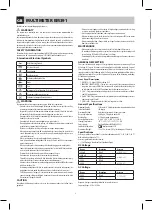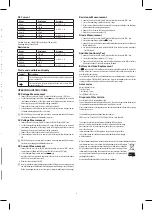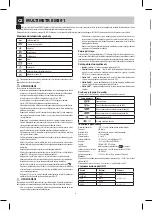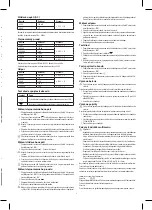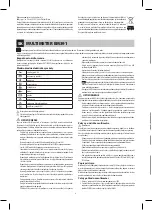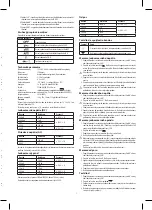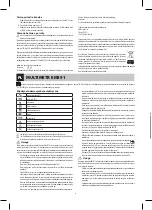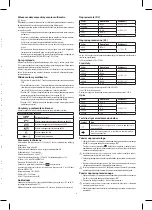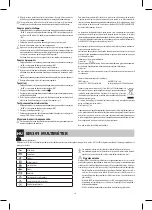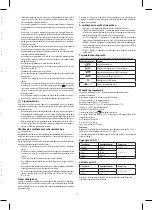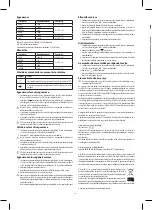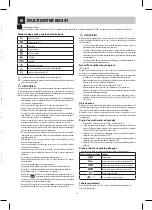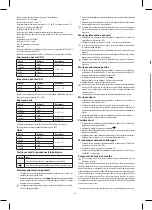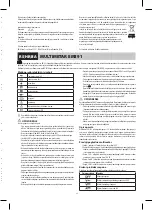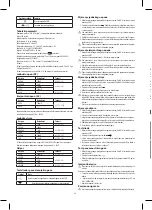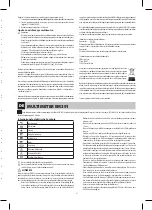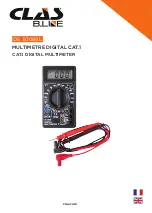
2
3
DC Current
Range
Resolution
Accuracy
20 µA
10 nA
±(1.2 % + 5)
200 µA
100 nA
±(1.0 % + 5)
2000 µA
1 µA
20 mA
10 µA
200 mA
100 µA
±(1.2 % + 5)
10 A
10 mA
±(2.0 % + 5)
Overload Protection: 250mA/250V fused (Range 10A unfused).
Measuring Voltage Drop: 200mV
Resistance
Range
Resolution
Accuracy
200 Ω
100 mΩ
±(1.0 % + 5)
2000 Ω
1 Ω
±(0.8 % + 5)
20 kΩ
10 Ω
200 kΩ
100 Ω
2000 kΩ
1 kΩ
±(1.2 % + 5)
Diode and audible continuity
Symbol
Description
The built-in buzzer will sound if the rezistance of the circuit under
test is less than 50 Ω
The approximate forward voltage of diode under test will be
diaplayed on the LCD
OPERATING INSTRUCTIONS
DC Voltage Measurement
1. Connect the red test lead to „VmAΩ“ jack and the black test lead to „COM“ jack.
2. Set the Function/Range switch to desired V range. If the voltage to be measured
is not known beforehand, set the range switch to the highest range and then turn it
down range by range until satisfactory reading is obtained.
3. Connect the test leads to the device or circuit to be measured.
4. Turn on the power of the device to be measured. The voltage value will appear on the
LCD along with the polarity of the red test lead.
When 600V range is exceeded please terminate measuring immediately. Otherwise
electric injury or damage of multimether can occur.
AC Voltage Measurement
1. Connect the red test lead to „VmAΩ“ jack and the blafl test lead to „COM“ jack.
2. Set the Function/Range swithc to desired V~ range. If the voltage to be measured
is not known beforehand, set the range switch to the highest range and then tur nit
down range by range until satisfactory reading is obtained.
3. Connect the test leads to the device or circuit to be measured.
4. Turn on the power of the device to be measured. The voltage value will appear on the
LCD.
When 600V range is exceeded please terminate measuring immediately. Otherwise
electric injury or damage of multimether can occur.
DC Current Measurement
1. Connect the red test lead to „VmAΩ“ jack and the black test lead to „COM“ jack (for
current between 200mA and 10A, connect the red test lead to „10A“ jack).
2. Set the Function/Range switch to desired A range.
3. Open the circuit to be measured, and connect the test leads in series with the load in
which the current is to be measured.
4. Read the current value on the LCD.
Never carry out measuring if voltage is higher than 250 V in open circuit. Such measuring
can lead to damage of multimether (fuse burning or electric discharge) or electric injury.
Before measuring make always sure that you are using the right range of measuring!
MULTIMETER EM391
Read this owner’s manual thoroughly before use
WARRANTY
This instrument is warranted to be free from defects in material and workmanship for
a period of one year.
Any instrument found defective within one year from the delivery date and returned to the
factory with transportation charges prepaid, will be repaired, adjusted, or replaced at no
charge to the original purchaser. This warranty does not cover expandable items such as
batteries or fuse. If the defect has been cause by a misuse or abnormal operation conditions,
the repair will be billed at a nominal cost.
SAFETY INFORMATION
The multimeter has been designed according to IEC-61010 concerning electronic measuring
instruments with a measurement category (CAT II 600V) and Pollution degree2
International Electrical Symbols
AC (Alternating Current)
DC (Direct Current)
Earth ground
Double Insulated
Deficiency of Built-In Battery
Diode
Fuse
Important safety information. Refer to the manual
Dangerous voltage may be present
Conforms to European Union directives
WARNING
To avoid possible electric shock or personal injury, follow these guidelines:
•
Do not use the meter if it is damaged. Before you use the meter, inspect the case. Pay
particular attention to the insulation surrounding the connectors.
•
Inspect the test leads for damaged insulation or exposed metal. Check the test leads
for continuity. Replace damaged test leads before you use the meter.
•
Do not use the meter if it operates abnormally. Protection may be impaired. When in
doubt, have the meter serviced.
•
Do not operate the meter around explosive gas, vapor, or dust.
•
Do not apply more than the rated voltage, as marked on the meter, between terminals
or between any terminal and earth ground.
•
Before use, verify the meter’s operation by measuring a known voltage.
•
When measuring current, turn off circuit power before connecting the meter in the
circuit. Remember to place the meter in the circuit. Remember to place the meter in
series with the circuit.
•
When servicing the meter, use only specified replacement parts.
•
Use with caution when working above 30V ac rms, 42V peak, or 60V dc. Such voltages
pose a shock hazard.
•
When using the probes, keep your fingers behind the finger guards on the probes.
•
Connect the common test lead before you connect the live test lead. When you discon-
nect test leads, disconnect the live test lead first.
•
Remove the test leads from the meter before you open the case.
•
Do not operate the meter with the cover removed or loosened.
•
To avoid false readings, which could lead to possible electric shock or personal injury,
replace the batteries as soon as the low battery indicator appears.
•
Do not use the test leads to measure the voltage which is more than 600V or the current
which is more than 10A.
•
Remaining endangerment: When an input terminal is connected to dangerous live
potentional it is to be noted than this potential at all other terminals can occur!
•
CATII-Measurement Category II is for measurements performed on circuits directly
connected to low voltage installation. Do not use the meter for measurements within
Measurement Categories III and IV.
CAUTION
To avoid possible damage to the meter or to the equipment under test, follow these
guidelines:
•
Disconnect circuit power and discharge all high voltage capacitors before testing
resistance, continuity, diodes, or capacitance.
•
Use the proper terminals, function, and range for your measurements.
•
Before measuring current, check the meter’s fuse and turn power OFF to the circuit
before connecting the meter to the circuit.
•
Before rotating Function / Range switch to change functions, disconnect test leads
from the circuit under test.
MAINTENANCE
•
Before opening the case, always disconnect the test leads from all live circuits.
•
To continue protection against fire, replace fuse only with the specified voltage and
current ratings: F250mA/250V (Fast Blown) 5× 20mm
•
Periodically wipe the case with a damp cloth and mild detergent. Do not use abrasives
or solvents.
GENERAL DESCRIPTION
This series instruments are compact 3 ½ digit digital multimeters for measuring DC and
AC Voltage, DC Current, Resistance and testing Diode and Audible Continuity. Some of
them also provide Temperature measurement or Battery test function, or can be used as a
signal generator (see the following table). Full range overload protection and low battery
indication are provided. They are ideal instruments for use in fields, laboratory, workshop,
DIY and home applications.
Front Panel Description
1. DISPLAYS – 3 ½ digit LCD, Max. reading 1999
2. FUNCTION / RANGE SWITCH – This switch is used to select the function and desired
range as well as to turn ON/OFF the instrument. To extend the life of the battery, the
switch should be set to the „OFF“position when the instrument is not in use.
3. „10A“ – Plug in connector for the red (positive) test lead for current (between 200mA
and 10A) measurements.
4. „VmAΩ“ JACK – Plug in connector for the red (positive) test lead for all voltage, resistence
and current (up to 200mA)
5. „COM“ JACK – Plug in connector for the black (negative) test lead.
General Specifications
Maximum Display:
1999 counts ( 3 ½ digits) with automatic polarity indication
Indication Method:
LCD display
Measuring Method:
Dual-slope integration A/D converter system
Over range Indication:
Only figure „1“ displayed on the LCD
Reading Rate:
2–3 times/second (approximate)
Operating Temperature:
0 °C–40 °C (32 °F–104 °F), 75 % R.H.
Storage Temperature:
-10 °C–50 °C (14 °F–122 °F), 75 % R.H.
Power Supply:
One 9-volt battery (NEDA1604, 6F22)
Low Battery Indication:
“
” displayed on the LCD
Dimensions/Weight:
138 × 70 × 28 (mm)/115 g (including one 9V battery)
Specifications
Accuracy is specified for a period of 1 year after calibration and at 18 °C–28 °C (64 °F–82 °F)
with relative humidity up to 75 %.
Accuracy specifications take the form of:
+/- (% of R(Number of Lest Significant Digits)
DC Voltage
Range
Resolution
Accuracy
200 mV
100 µV
±(0,5 % + 5)
2000 mV
1 mV
±(0,8 % + 5)
20 V
10 mV
200 V
100 mV
600 V
1 V
±(1 % + 5)
AC Voltage
Range
Resolution
Accuracy
200 V
100 mV
±(1.2%+10)
600 V
1 V
Response: Average responding, calibrated in rms of a sine wave.
Frequency Range: 45 Hz ~ 450 Hz
GB


